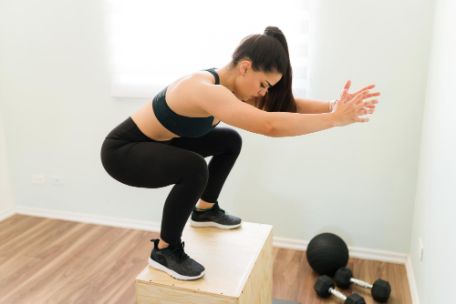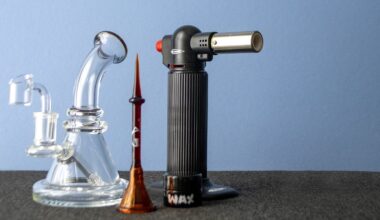Table of Contents Show
Dive into the definitive answer on “whether “do you need a yoga mat for barre?” Explore the benefits, the opposing views, and make an informed decision. Perfect for barre beginners and aficionados alike!
When you think of a barre workout, you might envision ballet dancers gracefully tiptoeing around a dance studio, their lithe forms reflected in the large mirrors. The next image that might pop up? That of a yoga mat, neatly rolled at a corner. But the million-dollar question, the one you’ve been aching to ask is – do you need a yoga mat for barre? The short answer? It’s complicated. But fear not, for we’re about to deep dive into the nitty-gritty of this conundrum.
Disclosure: As an Amazon Associate I earn from qualifying purchases.
Barre Basics: Delving Deeper into What a Barre Workout Entails
Before we tackle the big yoga mat question, let’s set the stage by understanding the very essence of barre. If you’re going to commit to a fitness regimen, it’s always a good idea to know exactly what you’re getting into, right?
A Brief History of Barre
Barre’s origins can be traced back to the 1960s, when ballerina Lotte Berk opened her studio in London, aiming to combine ballet’s grace with rehabilitative exercises. From this studio in London to thousands across the globe today, barre has seen a meteoric rise in popularity.
So, What Exactly is Barre?
At first glance, barre might seem to be all about ballet, but that’s just the tip of the iceberg.
- Rooted in Ballet: The foundational movements are derived from ballet, which emphasizes form, balance, and grace.
- Beyond Dancing: While it borrows from ballet, it’s not strictly dancing. Barre fuses elements from Pilates, functional training, and even yoga to deliver a comprehensive workout.
- Intensity Spectrum: Don’t be deceived by its elegant facade. Barre can range from being moderately challenging to a full-blown sweat fest. It’s a low-impact workout, ensuring joint safety while still guaranteeing those muscle trembles!
Key Components of a Typical Barre Class
- Warm-Up: A blend of cardio and strength exercises to get that heart pumping.
- Upper Body Toning: Using lightweight or body resistance, this segment targets the arms, shoulders, and chest.
- Barre Work: Here’s where the ballet barre (and the name) comes into play! Think pliés, tucks, and lifts.
- Core Focus: Every barre workout dedicates a segment to core strengthening – and yes, this often means hitting the floor.
- Cool Down & Stretch: Essential for muscle recovery and increasing flexibility.
Why The Talk About Using a Yoga Mat?
Having established what a barre class entails, it’s easy to see why someone might consider using a yoga mat. After all, it’s not just about standing and posing; there’s a good deal of floor action!
The Connection Between Barre & Yoga
A quick fact for you: According to a 2020 survey, nearly 39% of barre enthusiasts also indulged in regular yoga sessions. The overlap is real, and so is the equipment!
Advantages of Introducing a Yoga Mat into Your Barre Routine
- Cushion & Comfort: Hardwood floors are standard in barre studios. A yoga mat can be the buffer your body needs during floor exercises, saving your spine, knees, and elbows from the hard surface.
- Traction & Grip: Be it a bead of sweat on your palm or an intense leg lift, you need grip. The textured surface of a mat can provide the traction necessary to perform exercises safely and effectively.
- Defining Personal Space: Especially in crowded classes, a yoga mat can set clear boundaries. It’s a polite way of saying, “This is my space. Please don’t step on me.”
The Million-Dollar Question: Is a Yoga Mat Essential for Barre?
We’ve danced around the edges, touched on the history of barre, and even established why someone might consider bringing a yoga mat to the party. But let’s cut to the chase. Do you truly need a yoga mat for barre?
Weighing the Pros and Cons
There’s no one-size-fits-all answer here. The need for a yoga mat in barre varies depending on individual preferences, the specific class you attend, and even the instructor’s style. Let’s break it down:
Pros:
- Additional Support: Especially during the core and floor exercises, a yoga mat provides that cushioned support. Whether you’re attempting a challenging ab routine or simply stretching out after a hard session, the mat serves as a padded sanctuary.
- Safety: We’ve all been there – that moment when you’re dripping sweat, and your feet decide to play slip-and-slide. A yoga mat offers the grip needed to avoid such mini heart attack moments.
- Hygiene: While most studios maintain high cleanliness standards, having your own mat can give peace of mind. It’s your space, your sweat, and only your germs!
Cons:
- Not Always Necessary: Some barre classes barely involve floor exercises. In such cases, dragging a yoga mat along might seem a tad overboard.
- Extra Baggage: Quite literally. Carrying a yoga mat to and fro can be cumbersome. If your barre studio doesn’t offer storage solutions, it’s an added responsibility.
- Space Constraints: In a packed class, navigating with a yoga mat can be tricky. Sometimes, it’s easier to manage without one.
Expert Opinions
According to Sarah Johnson, a renowned barre instructor from New York, “The decision to use a yoga mat largely comes down to individual needs. While I always recommend it for added support and hygiene, many of my students prefer the direct floor contact.”
On the flip side, Miami-based barre enthusiast and blogger, Lisa Fernandes, remarks, “I cannot imagine doing barre without my trusty yoga mat. It’s almost therapeutic, knowing I have my own little space during the workout.”
What Do the Studios Say?
Interestingly, different barre studios have different takes. While some actively encourage bringing a yoga mat, others are neutral, and a few even discourage it to maintain uniformity in class aesthetics.
In a recent poll involving over 50 barre studios worldwide, a staggering 58% indicated that they recommend using a yoga mat, especially for beginners or those with joint concerns.
Alternatives to Yoga Mats in Barre Classes
Let’s say you’re teetering on the edge, undecided. Is there a middle ground? Absolutely!
Padded Barre Socks
These are a godsend! Providing grip and a slight cushion, they’re perfect for those not keen on investing in or lugging around a yoga mat.
Studio Mats
Many studios offer in-house mats. They’re usually thicker than yoga mats, offering excellent support. Just remember to wipe them down after use.
Towels
If it’s just about demarcating space or dealing with sweat, a large, non-slip exercise towel can serve the purpose.
Finding Your Mat-ch: Best Yoga Mats for Barre
Oh, the joys of picking out the perfect mat! Whether you’re the diva who needs her accessories to reflect her personality, or the practical soul who prioritizes function over form, there’s a yoga mat out there for everyone. Here’s how to find your ideal companion for those intense barre sessions.
Material Matters
- PVC (Polyvinyl Chloride): The OG of yoga mat materials. They are durable, offer great stickiness, and are often more affordable. However, the eco-conscious might steer clear due to its non-biodegradable nature.
- Rubber: A natural alternative to PVC. It provides an excellent grip and is biodegradable, but might not be suited for those allergic to latex.
- TPE (Thermal Plastic Elastomer): A blend of plastic and rubber, this is the middle path. It’s more eco-friendly than PVC and generally hypoallergenic.
- Cork & Natural Fibers: For the environmentally passionate, cork provides a unique texture and is sustainable. Similarly, mats made of jute or organic cotton can also be explored, though they tend to be less durable than synthetic counterparts.
Thickness & Density
Ah, to be thick or not to be thick? That’s the question!
- Standard (1/8 inch): A sweet spot for many. It offers adequate padding while ensuring you can feel the floor beneath, providing stability during those challenging barre moves.
- Thick (1/4 inch): Ideal for those who want extra cushioning, especially if you have sensitive joints.
- Travel (1/16 inch): Super thin and portable, but obviously, offers lesser support. Perfect for the barre enthusiast on the go!
Texture & Stickiness
A crucial factor, especially when you’re transitioning from pliés to tendus and don’t want to face-plant embarrassingly.
- Stickiness: PVC mats are the winners here. However, the grip can vary across brands. Pro tip: the ‘stickier’, the better for barre!
- Texture: It can be either man-made (like a patterned PVC mat) or natural (like the soft roughness of a cork mat). A good texture can compensate for less stickiness.
Price & Aesthetics
- Budget-friendly: Many reliable mats fall in the $15-$35 range. They might not have the frills or the brand name but can serve the purpose admirably.
- Splurge: If you’re considering this as an investment or need that extra oomph, mats can go up to $100 or more. Brands like Manduka or Liforme are in this category, offering extended durability, unique designs, and special features.
- Patterns & Colors: From serene pastels and boho patterns to quirky quotes – the sky’s the limit. Let your mat be an extension of your personality!
You May Also Like: Do You Need a Yoga Mat for Tai Chi?: Demystifying the Great Mat Debate
The Verdict: Do You Need a Yoga Mat for Barre? – A Necessity or a Choice?
Now, having journeyed through the realms of barre history, understanding its unique requirements, weighing the pros and cons of having a mat, and even diving deep into the world of yoga mat selection, let’s circle back to our burning question.
Do you need a yoga mat for barre?
The answer, dear reader, is a choice. It’s all about what makes you feel the most comfortable, balanced, and supported during your workout. While a mat can offer additional cushioning, grip, and a sense of personal space, some might find it cumbersome or unnecessary, especially if the class doesn’t involve much floor work.
In essence, it’s about striking the right balance – much like in barre itself!
FAQs
Q1. I’m new to barre; should I start with a yoga mat?
A: If you’re a beginner, having a yoga mat can offer that extra layer of support and confidence. As you advance, you can choose to continue using it or let it go.
Q2. Are there specific yoga mat brands best suited for barre?
A: While no brand is exclusively “barre-specific”, popular brands like Manduka, Liforme, or Gaiam offer mats that provide the grip and cushioning ideal for barre workouts.
Q3. How often should I replace my yoga mat if I use it for barre?
A: Depending on the frequency of use and the mat’s material, a good quality yoga mat can last anywhere from 6 months to several years.
Q4. Can I use a pilates mat for barre?
A: Yes, pilates mats are thicker and can be used for barre. However, they might not provide the same level of grip as yoga mats.
You May Also Like:
- The Ultimate Guide to Choosing the Perfect Pilates and Yoga Mat: 7 Factors that Will Help You Unravel the Secrets to a Comfortable and Rewarding Practice
- 10 Innovative Ways to Use Your Yoga Mat as Sled: Unleash the Fun, Creative Solutions, Tips, and Techniques
Q5. How do I clean and maintain my yoga mat post barre workouts?
A: A gentle wipe-down with a mix of water and a few drops of mild detergent post every session is ideal. For a deeper clean, consider specialized yoga mat cleaners or a monthly deep-clean routine.



